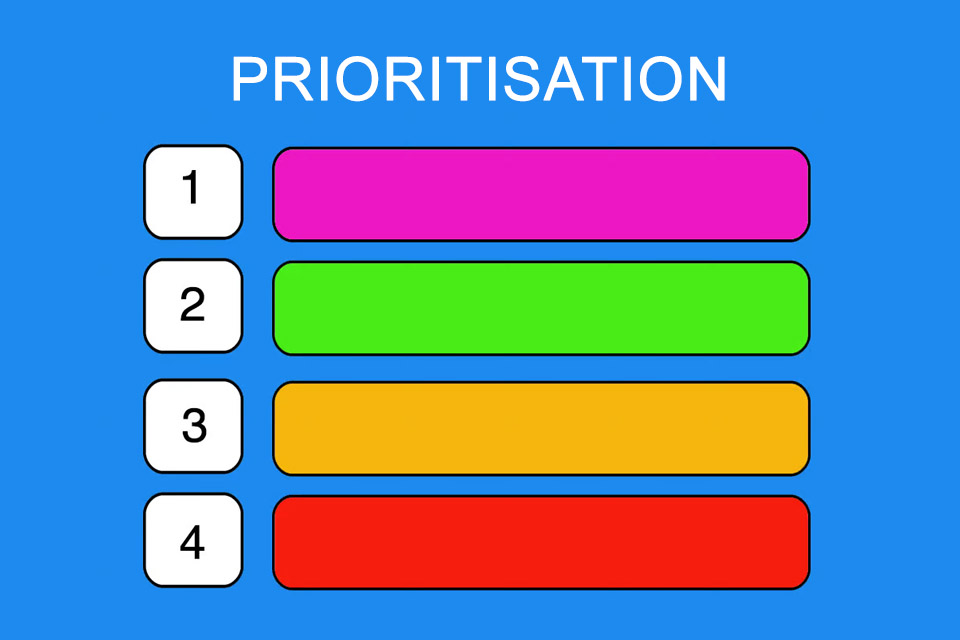Smartpedia: Prioritisation is the process of evaluating similar elements – e.g. tasks, requirements, projects – according to deliberately chosen criteria with the aim of achieving a ranking of elements.
Prioritisation – determining the ranking of similar elements
You have more tasks than you can do in one day. You have more requirements than you can handle in one iteration. Or you have several potential projects and need a decision which of these projects you want to implement first. There are many situations where people and organisations have to define sequences. The process of evaluating similar elements according to deliberately chosen criteria with the goal of achieving a ranking of the elements is called prioritisation.
Practically everything that people and/or organisations do can be prioritised. For example:
- tasks,
- work packages,
- work assignments,
- requirements,
- user stories,
- change requests,
- risks,
- impediments,
- ideas,
- use cases,
- stakeholders,
- objectives or
- projects.
Of course, the list is far from complete.
Criteria for Prioritisation
The criteria used to determine a ranking can be chosen freely, but depending on the element in question. For example, requirements can be classified in a “must have” category; requirements that are placed in such a category “must” be fulfilled. However, there is no “must have” category for risks or impediments.
Of course, organisations can choose to define their own criteria. However, they can also use well-known methods, as these use appropriate criteria to determine the ranking of similar elements.
Methods for Prioritisation
There are different methods of prioritisation for the different elements. Here you will find a list of some methods and practical tools:
- The Eisenhower Matrix is a method for prioritising tasks and helps to distinguish between important and unimportant, urgent and non-urgent tasks.
- A decision matrix is a tool for selecting the best alternative from various options, taking into account defined criteria. Since in the practice of decision making not all criteria are always equally important, they are often weighted with separate factors.
- A decision tree visualises a multi-stage decision process with all decision options. The purpose of a decision tree is to arrive at a final decision on the basis of various visualised answer options to concrete questions. In theory, it is suitable for all types of decisions and prioritisations.
- The Pugh-Matrix is a decision aid for prioritising competing concepts compared to a basic concept. It is based on a set of defined weighted criteria, the evaluation of alternatives compared to a basic solution, the multiplication of the evaluations with the respective weightings and the subsequent addition of the weighted evaluations.
- A business case is used to assess the possible financial and strategic effects of a company’s investment in a project or undertaking. The assessment is carried out as a comparison of different options for action on the basis of a profitability analysis.
- The risk matrix is a graphic representation of an identified risk situation. The positioning of the risks enables a comparison of the risks and is the basis for the definition and prioritisation of measures to minimise the main risks.
- The Precedence Diagram Method visualises activities that are on the critical path and that are essential for achieving deadlines or project goals. It thus helps to identify and prioritise activities that are necessary to achieve the project goals.
- The MoSCoW Method is a procedure for prioritising requirements, goals or activities that defines four categories (Must, Should, Could and Won’t).
- The Kano Model describes the relationship between customer satisfaction and the fulfilment of customer requirements. It shows that individual product features are of varying importance for customer satisfaction, so that the implementation of corresponding features should be prioritised.
- The stakeholder analysis determines the most important stakeholders for a project or development. It provides the basis for stakeholder communication including prioritisation.
- The ABC analysis is an analysis procedure for weighting objects according to their importance. It can be used, for example, to prioritise work packages in project management, in sales when classifying customers and sales areas, or in materials management when considering rationalisation.
- The XYZ analysis is a procedure in business administration or materials management in which items – i.e. goods, merchandise, services, etc. – are classified according to their sales regularity. The findings of the XYZ analysis are important for the timely production of articles or the procurement of goods.
The more areas you look at, the more methods for prioritisation you will find. In portfolio management, for example, the project dependency analysis or the cost utility analysis are used to prioritise projects and make investment decisions. The Ivy Lee Method requires the prioritisation of a maximum of 6 daily tasks, whereby the task with the highest priority should be completed first. The Eat-that-Frog Method propagates to make the most unpleasant task the first daily issue. In production planning there are heuristics with priority rules for machine allocation. And processor cores in computers know a priority scheduling to be able to perform more important processes more often than less important ones.
In short, the number of methods, techniques or tools for evaluation, weighting or weighting is almost limitless.
Tips for Prioritisation
The result of an evaluation or weighting is a ranking of elements from which priorities can be derived. The term “priority” is derived from the Latin word “prior” – the front one. In the practice of weightings, there are always situations in which prioritisation only apparently produces a ranking and thus a structure for processing. For example, requirements are often divided into three categories: very important, important, desirable. Such a classification often leads to a long list of requirements ending up in the first category “very important”, because any other classification means that a requirement will probably never be implemented due to the number of requirements. A few tips can be derived from such a situation:
- Work with absolute values and not with classifications. A request with priority 984 is more important than one with priority 983.
- If you (have to) work with classifications, ensure that the weighting criteria are transparent. If possible, have the evaluation carried out by a “neutral” role such as the product owner or product manager. Alternatively, you can also perform the weighting in a team.
- Use quantity restrictions such as the Ivy Lee Method or the WIP Limit from Kanban. And learn, for example, from key figures such as Velocity.
- If you set priorities that influence customers, colleagues, employees or other projects and developments, communicate them. Justify any decisions you make.
- Depending on the element, the process of evaluation can be a continuous task. In Backlog Refinement and Sprint Planning, for example, this regularly leads to new rankings based on new insights and assessments.
- …
It is not surprising that the list of tips can also be easily extended.
Does not-to-do list also serve as a method of prioritisation?
Notes:
Interestingly, in various contributions and articles on prioritisation, there are references to the ALPEN method, the SMART method or even Walking Skeleton, although these are not originally prioritisation methods. The 80-20 rule or the Pareto principle also “merely” explains that a small number of high values contributes more to the total value of a defined set of values than a high number of small values. Only in combination with ABC analysis, for example, does the topic of prioritisation come into play.
If you like the article or would like to discuss it, please feel free to share it in your network. And if you have any comments, please do not hesitate to send us a message.
Here you can find additional information from the t2informatik Blog:




